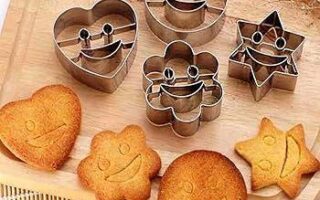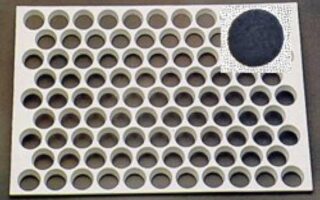In a world where individuality is celebrated yet standardization prevails, the humble cookie cutter stands as a curious emblem of both creativity and conformity. From the simple, nostalgic shapes that adorn our holiday treats to the intricate designs that inspire artisan bakers, this unassuming kitchen tool has transcended its utilitarian roots to become a symbol of culinary art. But what lies behind the allure of the cookie cutter? In this exploration, we will delve into its history, its evolution, and its impact on how we perceive and produce food. Join us as we unveil the multifaceted role of the cookie cutter—not merely as a means to shape dough, but as a bridge between tradition, innovation, and the shared joy of baking.
Table of Contents
- Exploring the Versatility of Cookie Cutters in Baking
- Choosing the Right Material for Your Cookie Cutter Needs
- Creative Techniques to Elevate Your Cookie Decorating Skills
- Caring for and Storing Your Cookie Cutters for Longevity
- Q&A
- In Summary
Exploring the Versatility of Cookie Cutters in Baking
Cookie cutters offer an enchanting array of possibilities beyond the classic round shape. From seasonal motifs like snowflakes and pumpkins to whimsical shapes such as stars and animals, these handy tools can transform any baking escapade into a delightful experience. The versatility is not just limited to cookies; with a dash of creativity, you can also use cookie cutters for other culinary creations, including sandwiches, cheeses, and even fruit. By incorporating interesting themes or seasonal elements, you can elevate a simple dessert or snack into an eye-catching centerpiece for any gathering. Here are a few ideas for versatile uses:
- Decorative shortbreads: Imprint unique shapes that can be decorated with icing or glaze.
- Fruity treats: Use cutters to shape fun fruit kabobs or salads for kids.
- Cheese platters: Create adorable cheese shapes that will enhance your appetizer spread.
- Creative pancakes: Ring in breakfast with playful pancake shapes that will charm any morning meal.
Using cookie cutters can also significantly simplify the process of portioning and presentation, making it easier to achieve uniformly sized treats. For instance, when preparing decorated cookies for a party, you can create an array of shapes that guests will love, while ensuring consistent thickness for even baking. To inspire your next baking venture, here’s a simple comparison table outlining some popular cookie cutter shapes paired with their best uses:
| Cookie Cutter Shape | Best Used For |
|---|---|
| Heart | Romantic occasions and Valentine’s Day |
| Star | Celebrations like birthdays and holidays |
| Animal | Children’s parties and fun events |
| Flower | Spring gatherings and Mother’s Day treats |
Choosing the Right Material for Your Cookie Cutter Needs
When it comes to cookie cutters, the material you choose can significantly influence the design precision and the ease of use. Options like stainless steel, plastic, and silicone each have unique qualities that cater to different baking styles. Stainless steel is often favored for its durability and ability to retain sharp edges, making it perfect for intricate shapes and crisp outlines. On the other hand, plastic cookie cutters are lightweight and often come in a variety of colors and designs, appealing to those seeking fun and lighthearted baking experiences. Silicone offers flexibility and non-stick properties, ensuring easy release of your beautifully shaped cookies without compromising on details.
In considering your options, it’s essential to weigh the benefits and drawbacks of each material. Here’s a quick comparison to guide your choice:
| Material | Durability | Flexibility | Ease of Use |
|---|---|---|---|
| Stainless Steel | Very High | Low | Moderate |
| Plastic | Moderate | High | Very Easy |
| Silicone | High | Very High | Very Easy |
Ultimately, selecting the right material will depend on your baking habits and personal preferences. Whether you’re a seasoned baker or just starting, understanding the strengths of each type will make your cookie-decorating adventures all the more enjoyable.
Creative Techniques to Elevate Your Cookie Decorating Skills
Exploring the world of cookie decorating takes on a whole new level when you master the art of using cookie cutters in innovative ways. Beyond the traditional shapes, consider embracing a variety of techniques to reshape your decorating process. For instance, layering techniques can add depth and character to your cookies. Use a simple round cutter to cut twice, creating a small circle on top of a larger one, providing a canvas for additional icing work or sprinkles to be placed strategically. Alternatively, try combining different sizes of cookie cutters to create mixed-modal shapes that can yield unique designs. For example, stacking a heart-shaped cookie atop a circle can turn your sweet treats into delightful layered desserts.
Texture is another element that can dramatically enhance your creations. By using textured rolling pins or adding details with small tools, you can create visually appealing cookies. Here are a few ideas to spark your creativity:
- Use edible glitter for a festive sparkle.
- Incorporate stencils to add intricate designs with colored icing.
- Try prints with leaves or patterns to give your cookies a natural flair.
- Experiment with marbling icing colors to create a stained-glass effect.
Investing in a versatile set of cookie cutters can also inspire themed decorating sessions. Consider this table for favorite holiday shapes:
| Holiday | Cookie Cutter Shape |
|---|---|
| Christmas | Tree, Snowman, Star |
| Halloween | Pumpkin, Ghost, Bat |
| Valentine’s Day | Heart, Flower, Cupid |
| Summer | Sun, Ice Cream, Beach Ball |
By infusing creativity through different techniques and experimenting with various shapes, you can transform your cookie decorating from simple to extraordinary. Dive into the possibilities, and watch your cookie creations come to life!
Caring for and Storing Your Cookie Cutters for Longevity
To ensure that your cookie cutters maintain their shape and sharpness, it’s essential to clean them properly after each use. Start by rinsing them in warm, soapy water and gently scrubbing with a soft sponge to remove any dough residue. Avoid using abrasive materials, as they can scratch the surface. After washing, pat them dry with a soft cloth to prevent rusting and moisture retention. For metal cookie cutters, consider applying a light coat of food-safe mineral oil to protect them from tarnishing. This simple maintenance routine will help preserve your favorite cutting tools for years to come.
When it comes to storage, choose a cool, dry place to keep your cookie cutters organized. You can use the following methods to store them effectively:
- Plastic containers: Stackable bins help save space and keep them secure.
- Magnetic strips: Attach small magnets to the back of metal cutters and display them on your fridge.
- Hanging organizers: Utilize hooks or over-the-door organizers to hang your cookie cutters, blending functionality with charm.
In addition to these methods, consider a labeled bin if you have various shapes. This allows you to locate your favorite cookie cutter quickly, maximizing your baking efficiency. Regular care and thoughtful storage will not only help in maintaining the aesthetic appeal of your collection but also ensure they remain a reliable baking partner whenever the craving for cookies arises.
Q&A
Q&A: The Underrated Charm of the Cookie Cutter
Q: What exactly is a cookie cutter, and where did it originate?
A: A cookie cutter is a kitchen tool used to cut dough into specific shapes before baking. Traditionally, it consists of a metal or plastic outline that can take on various forms—from classic geometric shapes to whimsical designs like animals and holiday motifs. While the exact origins are hazy, cookie cutters are believed to date back to Ancient Egypt, where they likely were first crafted from materials such as wood and metal.
Q: Why are cookie cutters more than just a baking tool?
A: Cookie cutters are a canvas for creativity and nostalgia. They transform a simple baking activity into a fun art project, allowing bakers of all ages to express themselves. Additionally, they play a significant role in cultural traditions, such as shaping festive cookies for holidays, celebrating family recipes, and creating memories in the kitchen.
Q: Can you share some tips for using cookie cutters effectively?
A: Certainly! Here are a few pro tips:
- Choose your dough wisely: Stick to cookie dough that holds its shape well, like sugar or gingerbread.
- Chill your dough: Refrigerating the dough before cutting helps prevent it from sticking and losing shape.
- Flour your cutter: Lightly dusting the cutter with flour helps maintain a clean cut and prevents sticking.
- Press firmly: Ensure you apply even pressure while cutting to get a clean shape.
- Don’t forget the details: For intricate shapes, use a toothpick to nudge out any stuck bits after cutting.
Q: Are there any unusual uses for cookie cutters?
A: Absolutely! Cookie cutters can serve various purposes beyond baking. They can be used to create decorative elements in crafting projects, like cutting out shapes from felt or paper for scrapbooking. Additionally, they can shape sandwiches, pancakes, or cheese for a whimsical lunch, or even be employed in gardening to shape soil into fun designs.
Q: What’s the appeal of themed cookie cutters, like those for holidays or special occasions?
A: Themed cookie cutters bring an element of fun and festivity to any occasion. They enable bakers to visually enhance celebrations, from heart shapes for Valentine’s Day to spooky ghosts for Halloween. These themed creations often become centerpieces at gatherings, inviting conversation and enhancing the overall experience of the event.
Q: How do cookie cutters evolve with modern trends?
A: As culinary trends shift, so do cookie cutters! Nowadays, one can find cookie cutters that cater to a wide array of interests, including pop culture references, geometric patterns, or even personalized designs. The rise of social media has also influenced this evolution—custom cutters that align with viral trends or themed parties are becoming increasingly popular, allowing people to showcase their unique styles and interests.
Q: What are some fascinating facts about cookie cutters that people might not know?
A: Here are a few fun tidbits:
- The largest cookie cutter ever made was roughly 16 feet tall and 8 feet wide, creating a giant cookie for a charity event!
- Some vintage cookie cutters can be quite valuable; collectors often seek out antique models that reflect historical designs.
- There’s a cookie cutter specifically designed for making “reconstructed” cookies, allowing bakers to cut pieces that fit together like a puzzle for a fun baking challenge!
—
Q: what is the lasting legacy of the cookie cutter?
A: The cookie cutter is more than just a tool—it symbolizes creativity, tradition, and togetherness. Its simple design belies its powerful ability to spark joy in the kitchen and connect generations through baking. Whether whipping up a batch of classic cookies or exploring new culinary adventures, the cookie cutter will likely remain a beloved staple in kitchens worldwide for years to come.
In Summary
As we wrap up our sweet journey through the world of the cookie cutter, it becomes clear that this unassuming tool holds a treasure trove of potential. From the playful shapes that bring joy to holiday gatherings to the intricate designs that fuel culinary creativity, cookie cutters are more than just kitchen gadgets—they are gateways to imagination and connection. Whether you’re a novice baker or a seasoned pastry artist, these simple devices invite us to explore, experiment, and express ourselves through the universal language of baked goods. As you embark on your own cookie-making adventures, remember that each shape tells a story waiting to be savored. So, grab your favorite cutter, roll out some dough, and let the magic of creation unfold. Happy baking!



